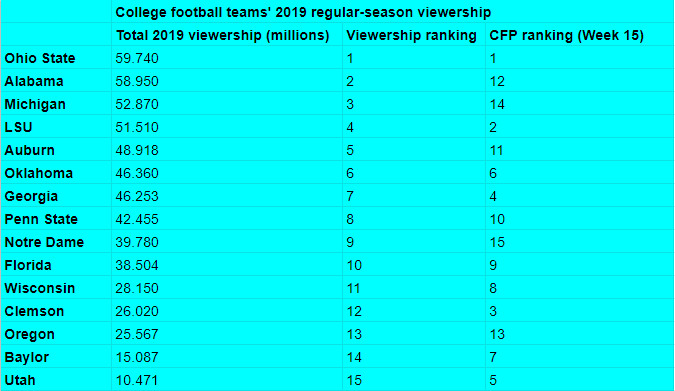There’s always a whole lot of discussion out there about the College Football Playoff rankings and what should matter in them, whether that’s overall strength of schedule, quality wins, close losses versus blowout losses, conference championships and more. The committee’s own published protocol discusses all of those criteria, but one thing it doesn’t mention (but that fans everywhere regularly reference) is TV viewership; some fans regularly claim that teams only receive high rankings because they’re seen to bring strong audiences with them. With that in mind, we decided to look at the Week 15 CFP rankings, run a list of how many viewers each of the current top 15 teams has drawn this year, and see how it compares to the rankings. Notes and disclaimers follow, but here’s that viewership list (using viewership data from Paulsen at Sports Media Watch):
How did we get those numbers? We went through each of these team’s schedules (via FBSchedules.com) and input the viewership numbers (in millions) for each game Paulsen listed on his Sports Media Watch ratings page here.
Now, most of those teams (everyone except Georgia) have at least one game with no viewership number listed above thanks to those games being on unrated networks (most conference networks), streaming, regional sports networks (one Baylor game), or pay-per-view (one Oklahoma game). Big Ten Network has ratings listed for some games, but not for all of them, so they’re included where available.
The data above (and in “raw totals” in the sheet below) makes no viewership assumptions; it treats every game without a listed rating as a zero. Those games obviously aren’t total zeros, so the sheet below also includes a “projected totals” guess at what things would look like with conference network games included, treating conference network games and a CBSSN game as one million viewers and treating ESPN+/PPV/RSNs as 500,000 viewers. That doesn’t change the order of relative viewership at all (similar adjustments are being made for most teams, and even teams like Utah that had four games without listed viewership totals don’t get enough of a bump to pass anyone), but it does change the viewership totals slightly. Here’s that sheet:
Is 1/0.5 a great assumption for all of these unlisted games individually? Not necessarily; it doesn’t distinguish between a conference matchup on a conference network and playing a lesser non-conference opponent (Group of Five or FCS) on a conference network, and the former tends to draw significantly more viewers than the latter. It may also undervalue some BTN games, especially for Ohio State; the two Ohio State BTN games we do have data for came in at 3.05 and 1.64 million viewers. However, Penn State drew just 522,000 viewers for a non-conference game on BTN against Idaho and just 627,000 for a conference game there against Rutgers, so BTN games aren’t necessarily all drawing over a million.
We don’t have any sort of viewership data for SECN, ACCN or PAC12N, but the 1.0 million assumption probably dramatically overestimates PAC12N viewership (given its carriage struggles), likely overestimates CBSSN viewership, and possibly undervalues SECN viewership (some of the top teams there may pull similar numbers to Ohio State on BTN, and SECN has slightly better carriage than BTN). And the 0.5 assumption isn’t necessarily great for individual games, either; for example, Baylor probably drew more viewers for its Fox regional networks game than its ESPN+ game, but both are treated as 0.5 here. However, the 1.0/0.5 assumption looks not too bad across the board (and it seems fairer than trying to individually predict each and every non-rated game’s ratings), and as mentioned above, it doesn’t change any team’s relative order. It just provides a viewership total that gives them some credit for games without public viewership totals.
The latest
So, what about the overall takeaways from this? Well, at this specific moment in time, this data contradicts the idea that the committee is all about TV ratings. In particular, Clemson, Utah, Baylor and Oregon are the four bottom teams in viewership, and they’re #3, #5, #7 and #13 in the current rankings respectively. Meanwhile, Michigan and Notre Dame are third and ninth in viewership, but #14 and #15 in the rankings.
However, this doesn’t invalidate all of the “the committee only cares about ratings” criticisms; a lot of those have come when they’ve ranked the likes of Alabama higher than many thought they should be ranked, and this particular week, they dropped the Crimson Tide seven spots after the Iron Bowl loss to Auburn. So just because Alabama’s lower than their viewership would suggest right now doesn’t mean that the committee never ranks teams too high based on viewership. It’s also worth keeping in mind that viewership here doesn’t necessarily determine viewership in the CFP; Clemson may be fourth from the bottom in season-long viewership, but they’ve drawn well in the playoff and the national title game in the past, and their poor viewership this year may be largely about the perceived lackluster opponents they’ve faced so far.
Another interesting thing here is that the potential playoff matchups could be dramatically different in terms of ratings potential. At the moment, the teams 5-8 in the rankings are probably the only ones on the outside with a shot of making it in, as they’re in conference championship games this week (and that’s even questionable for No. 8 Wisconsin given that they already have two losses; a win over No. 1 Ohio State in the Big Ten Championship gets them in the conversation, but does it get them in the playoff?). And the playoffs could look very different for broadcaster ESPN if a Utah or a Baylor makes it in as opposed to, say, current No. 4 Georgia; the Utes and Bears drew 35 and 30 million less viewers respectively this season than the Bulldogs. You can bet that the committee is never going to say “We put Team X in because of ratings potential,” and that may actually not be anything they explicitly consider (but there’s some correlation to things they do say they consider, such as strength of schedule), but there are certainly ratings implications to their decisions.







